Plastic Mixed Reinforced Concrete - Behaviour
Behaviour of Plastic Mixed Reinforced Concrete Columns Under Axial Compression
One of the main environmental problem today is the disposal of the waste plastics. The use of plastics in various places as packing materials and the products such as bottles, polythene sheets, containers, packing strips etc., are increasing day by day. This results in production of plastic wastes from all sorts of livings from industrial manufacturers to domestic users. To circumvent this pollution crisis, many products are being produced from reusable waste plastics. On the other side, the Indian construction industry is facing problems due to insufficient and unavailability of construction materials. So, we need to search for new construction materials as well as a method to dispose the plastic waste. To find a solution to the above problems, one of them can be used to solve the other. In this experimental study, an attempt has been made to use the waste plastics in concrete and studies have been conducted to focus particularly on the behavior of compression members with various proportions of plastic wastes. The plastics used in this investigation were polythene sheets, raw plastics (raw material used for straw manufacturing), road wastes (waste plastics collected from road sides are melted and shredded) and plastic straw. The above plastic wastes were mixed with cement concrete in various proportions (0.1% to 2%) and test specimens were cast (cubes and columns) to study the behavior of plastic mixed concrete in axial compression.
S. Gowri, Senior Lecturer, and N. Rajkumar, Lecturer, Dept of Civil Engg, Erode Sengunthar Engineering College, Thudupathi, Erode
One of the main environmental problem today is the disposal of the waste plastics. The use of plastics in various places as packing materials and the products such as bottles, polythene sheets, containers, packing strips etc., are increasing day by day. This results in production of plastic wastes from all sorts of livings from industrial manufacturers to domestic users. To circumvent this pollution crisis, many products are being produced from reusable waste plastics. On the other side, the Indian construction industry is facing problems due to insufficient and unavailability of construction materials. So, we need to search for new construction materials as well as a method to dispose the plastic waste. To find a solution to the above problems, one of them can be used to solve the other. In this experimental study, an attempt has been made to use the waste plastics in concrete and studies have been conducted to focus particularly on the behavior of compression members with various proportions of plastic wastes. The plastics used in this investigation were polythene sheets, raw plastics (raw material used for straw manufacturing), road wastes (waste plastics collected from road sides are melted and shredded) and plastic straw. The above plastic wastes were mixed with cement concrete in various proportions (0.1% to 2%) and test specimens were cast (cubes and columns) to study the behavior of plastic mixed concrete in axial compression.
S. Gowri, Senior Lecturer, and N. Rajkumar, Lecturer, Dept of Civil Engg, Erode Sengunthar Engineering College, Thudupathi, Erode
Introduction
The Indian concrete industry is today consuming about 400 million tonnes of concrete every year and it is expected, that this may reach a billion tonnes in less than a decade. All the materials required to produce such huge quantities of concrete, come from the earth’s crust, thus depleting its resources every year creating ecological strains. On the other hand, human activities on earth produce solid wastes in considerable quantities i.e., over 2500 million tonnes per year, including industrial wastes, agricultural wastes and other wastes from rural and urban societies. Disposal of such solid wastes involves economic issues as well as ecological and environmental considerations. The major ecological strain in disposal of solid waste may be due to the presence of waste plastics in it
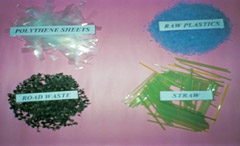
The plastic is one of the recent engineering materials which have appeared in the market all over the world. Some varieties of naturally occurring thermoplastics were known to Egyptians and Romans who extracted and used these plastics for various purposes. Plastics were used in bath and sink units, corrugated and plain sheets, floor tiles, joint less flooring, paints and varnishes and wall tiles. Other than these, domestically plastics were used in various forms as carry bags, bottles, cans and also in various medical utilities. There has been a steep rise in the production of plastics from a mere 30 million kN in 1955, it has touched 1000 million kN at present. It is estimated that on an average 25% of the total plastic production in the world is used by the building industry. The per capita consumption of plastics in the developed countries ranges from 500 to 1000N while in our country, it is only about 2N. There is however now increase in awareness regarding the utilization of plastic as a useful building material in our country. These types of usages normally generates more amount of wastes which are to be disposed off properly.
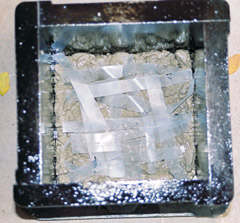
Environmentally sensitive aware people condemn the use of plastics for amount of pollution caused by them in disposal. However this is not a serious problem in comparison to the waste and pollution generated by a host of other industries. The non-biodegradable plastic products used for soft drink bottles, milk and juice bottles, bread bags, syrup bottles, coffee cups, plastics utensils etc., can be conveniently recycled into carpets, detergent bottle, drainage pipes, fencing, handrails, grocery bags, car battery cases, pencil holders, benches, picnic tables, road side posts etc,. The developing construction field consumes a huge amount of concrete and it leads to the depletion of natural products and causes environmental pollution.
Plastics are normally stable and not biodegradable. So, their disposal poses problems. Research works are going on in making use of plastics wastes effectively as additives in bitumen mixes for the road pavements. Reengineered plastics are used for solving the solid waste management problems to great extent. This study attempts to give a contribution to the effective use of waste plastics in concrete in order to prevent the ecological and environmental strains caused by them, also to limit the high amount of environmental degradation.
This study attempts to give a contribution to the effective use of domestic wastes (plastics) in concrete in order to prevent the environmental strains caused by them, also to limit the consumption of high amounts of natural resources.
Four types of plastic materials were selected to mix along with the concrete: (1) Polythene Sheet (2) Raw Plastics (3) Road Wastes (4) Plastic Straw to study their behavior in conjunction with concrete. The properties of the materials used in the present investigations were completely studied and the optimum mix of the above plastic materials was found based on their compressive, split tensile, flexural strengths. After finding the optimum mix percentages in compression, RC columns were cast and tested for its compressive strength. From the investigation, the road waste mixed concrete was found to take more loads in compression. Raw plastic mixed concrete as well as plastic straw mixed concrete were also found to give better strength than the reference RC column.

Figure 1: Photograph showing various Types of Plastic Materials Used in the Investigation

Figure 2: Photograph showing the Arrangement of Polythene Sheet in Cube Mould
Plastics are normally stable and not biodegradable. So, their disposal poses problems. Research works are going on in making use of plastics wastes effectively as additives in bitumen mixes for the road pavements. Reengineered plastics are used for solving the solid waste management problems to great extent. This study attempts to give a contribution to the effective use of waste plastics in concrete in order to prevent the ecological and environmental strains caused by them, also to limit the high amount of environmental degradation.
This study attempts to give a contribution to the effective use of domestic wastes (plastics) in concrete in order to prevent the environmental strains caused by them, also to limit the consumption of high amounts of natural resources.
Four types of plastic materials were selected to mix along with the concrete: (1) Polythene Sheet (2) Raw Plastics (3) Road Wastes (4) Plastic Straw to study their behavior in conjunction with concrete. The properties of the materials used in the present investigations were completely studied and the optimum mix of the above plastic materials was found based on their compressive, split tensile, flexural strengths. After finding the optimum mix percentages in compression, RC columns were cast and tested for its compressive strength. From the investigation, the road waste mixed concrete was found to take more loads in compression. Raw plastic mixed concrete as well as plastic straw mixed concrete were also found to give better strength than the reference RC column.
Literature Review
FORTA ECONO-NET manufactured by FORTA Corporation, USA is a homopolymer, polypropylene fibrous reinforcements in a collated fibrillated (network) form. This is used to reduce plastics and hardened concrete shrinkage, improves impact strength, increase fatigue resistance and concrete toughness. This product is non-corrosive, non-magnetic, chemically inert and 100% alkali proof.
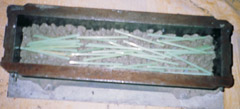
Lakshmipathy et.al. (2003), have done experimental investigations to study the suitability of the use of Re-engineered plastics as fibers for road pavements. The properties studied include compressive strength, tensile strength, flexural strength under reversed cyclic loading, impact resistance, plastic shrinkage and abrasion resistance etc., Efforts have been made to compare it steel fibers. The results have shown that the improvement of concrete properties at lower cost is obtained with Re-engineered plastic shred reinforced concrete.
Prabir Das (2004) has suggested that plastics can be used in construction industry at various places. Proper selection of material / grade and suitable design considerations can help to replace many more applications. Lighter weight, design flexibility, part integration, low system cost, very high productivity and improved product appearance are the main features for use of engineering plastics. The engineering thermoplastics and introduction of application specific grades has thrown challenges to conventional materials in the industries. This paper provides all the supports in selecting suitable engineering plastics, process and design for conversion of conventional material to engineering plastics for performance and system cost benefits.
Chandrakaran (2004) has explained a laboratory experimental study carried out to utilize waste plastics (in the form of strips) obtained from milk pouches in the pavement construction. Results of the study indicate that by adding plastic strips in the soil, shear strength, tensile strength and CBR values of the soil increases. In this study, plastic or polythene sheets having thickness of 0.5mm and which are made up of high density are used. Three types of plastic strips were used in this study to act as a reinforcing material. The first one was cut into 20mm x 40mm size, second one was 25mm x 50mm size and the third one was of 30mm x 60mm size. These plastic strips have innumerable advantageous properties like high tensile strength, low permeability etc., These plastic strips act as a good barrier to gases and liquids and are unaffected by cycles of wetting and drying. For all the strips used in this experimental work, an aspect ratio of 2 is maintained.
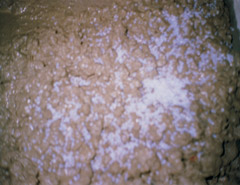
Agarwal (2004) has conducted pilot level studies using industrial PVC scrap to develop PVC board. Efforts have been made in developing innovative number of such alternative building materials. These would be helpful in saving our precious forest and environment efficiently and economically on commercial exploitation. Developed materials are mostly wood alternatives used in the construction of door shutters, frames, false ceiling, thermal insulation and alike applications. Developed sustainable alternative building materials are good economic replacement of wood and other reconstituted wood products commercially available and would be helpful in cost effective constructions.
Vasudevan (2004), in his report has given most useful ways of disposing waste plastics and laying roads have come to light in a research carried out by the Chemistry Department of Thiyagarajar College of Engineering. They have reported that the waste plastics may be used in block making modified light roofing, mastic flooring and polymer reinforced concrete. The novel composition of waste polymer-aggregate blend has been patented. They have suggested that utilization of waste plastics to enhance the binding property is better option than disposing or enforcing a blanket ban on the use of plastics. It has been reported that the per capita use of plastics in India is 3.5 kg, with virgin plastics accounting for 3.1 million tonnes and recycled plastics, one million. The use in Tamilnadu, with over 7000 units manufacturing material is put at 2.4 lakh tonnes per year. The ‘Garbage Culture’ has made disposal of waste plastic a major problem for civic bodies.
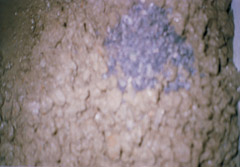
Disposal of used plastics by land filling may be temporary solution and also affects ground water recharging and soil microbe activities. Incineration of plastic material will cause air pollution, global warming and monsoon failure. Investigations done so far have shown that waste plastics can be utilized for making polymer aggregate blocks with ceramics and granite, which can be used in laying footpaths. The blocks can take 350 tonnes of load and prevents water penetration. They can also be used in lining of canals. A bitumen blend can be used as a coat over reinforced cardboard for roofing. Besides enhancing the strength and life of roofing, used by the poor, the blend will provide better moisture resistant. A blend of waste plastics with mastic components and flooring materials provides floors of more strength, especially in industrial units. Waste polymers also infuse greater strength when mixed with cement as a reinforced concrete. The author suggested the residents and the users to segregate the plastics in their area and to pool the segregated plastics for laying road with assistance of the civic body. Non-Governmental organizations can be involved in the collection of plastic waste and its segregation, taking in to account the money it can fetch.

Figure 3: Photograph showing the Arrangements of Plastic Straw in Prism Mould
Prabir Das (2004) has suggested that plastics can be used in construction industry at various places. Proper selection of material / grade and suitable design considerations can help to replace many more applications. Lighter weight, design flexibility, part integration, low system cost, very high productivity and improved product appearance are the main features for use of engineering plastics. The engineering thermoplastics and introduction of application specific grades has thrown challenges to conventional materials in the industries. This paper provides all the supports in selecting suitable engineering plastics, process and design for conversion of conventional material to engineering plastics for performance and system cost benefits.
Chandrakaran (2004) has explained a laboratory experimental study carried out to utilize waste plastics (in the form of strips) obtained from milk pouches in the pavement construction. Results of the study indicate that by adding plastic strips in the soil, shear strength, tensile strength and CBR values of the soil increases. In this study, plastic or polythene sheets having thickness of 0.5mm and which are made up of high density are used. Three types of plastic strips were used in this study to act as a reinforcing material. The first one was cut into 20mm x 40mm size, second one was 25mm x 50mm size and the third one was of 30mm x 60mm size. These plastic strips have innumerable advantageous properties like high tensile strength, low permeability etc., These plastic strips act as a good barrier to gases and liquids and are unaffected by cycles of wetting and drying. For all the strips used in this experimental work, an aspect ratio of 2 is maintained.

Figure 4: Photograph showing the Mixing of Raw Plastic with Concrete
Vasudevan (2004), in his report has given most useful ways of disposing waste plastics and laying roads have come to light in a research carried out by the Chemistry Department of Thiyagarajar College of Engineering. They have reported that the waste plastics may be used in block making modified light roofing, mastic flooring and polymer reinforced concrete. The novel composition of waste polymer-aggregate blend has been patented. They have suggested that utilization of waste plastics to enhance the binding property is better option than disposing or enforcing a blanket ban on the use of plastics. It has been reported that the per capita use of plastics in India is 3.5 kg, with virgin plastics accounting for 3.1 million tonnes and recycled plastics, one million. The use in Tamilnadu, with over 7000 units manufacturing material is put at 2.4 lakh tonnes per year. The ‘Garbage Culture’ has made disposal of waste plastic a major problem for civic bodies.

Figure 5: Photograph showing the Mixing of Road Waste with Concrete
Materials and Methods
In the experimentation, 43 Grade cement having specific gravity of 3.15 was used along with the locally available sand and aggregates. The fineness percentage of the cement used was 5%. The sand having specific gravity of 2.6 with fineness modulus of 3.5 falling under zone III was used. The coarse aggregate having a specific gravity of 2.61 with 20mm down size and 15mm down size were used in the experimentation.
Plastics Used in the Investigation
The four types of plastics used in this experimental investigation were thermoplastic products. They are,
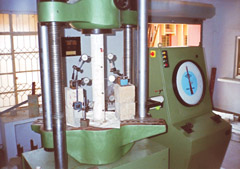
Figure 6: Photograph showing the Test Set-up for RC Column
- Polythene Sheet
- Road waste
- Raw Plastics
- Plastic Straw
- Polythene Sheet: The polythene sheets are organic polymers containing carbon in addition to hydrogen, oxygen, nitrogen. The thickness of the polythene sheet used in the present investigation was 250 microns.
- Road Waste: These are nothing but the waste plastics found on the road sides, which were collected and heated. After heating the products were cooled and the resultant product was shredded. These shredded plastic products were selected to mix along with concrete. This type of plastics was mentioned as road waste.
- Raw Plastics: The raw materials used for manufacturing the plastic straw were called as raw plastics. These were round shaped plastic granules which were white in color.
- Plastic Straw: These are tubular plastic products used in day today life. These were mixed along with concrete after cutting them along its cross section. Then the cast specimens were de-moulded next day and subjected to curing.
Test Methodology
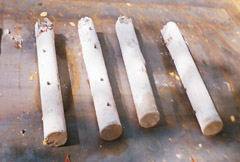
Figure 7: Photograph showing the Tested RC Column Specimens
Results and Discussions
Casting of Test Specimen
Dimensions of the Test Specimens
The column is of size 100 mm diameter and 750mm height. The longitudinal bars of the column consist of 6 nos. of 6mm diameter. The lateral ties of 5mm diameter plain bars placed at 85mm c/c have been used.
Materials Used
OPC 43 grade, river sand and crushed granite aggregates, potable water were used for making the concrete. Various types of plastic waste with their optimum percentage as discussed in previous chapter were mixed with conventional concrete to determine the effect of plastic on the column behavior. The weight of plastics added is given in Table 1.
Casting
The columns were cast in the vertical position. The reinforcement cage is inserted in to the PVC mould. The cut polythene sheets were arranged in layer by layer in between concrete layers. The other plastic materials like road wastes and raw plastics were weighed to their optimum percentage and mixed with the concrete and then poured in to the mould. The plastic straw was cut along its cross section and arranged in layers in between concrete. The table vibrator is used to achieve better compaction. The next day the specimens were de-moulded and subjected to curing for specified number of days.
After the specified curing period (7 days), the specimens were taken out for testing.
Test Set-up
The column specimens cast by using various plastic mixed concrete were tested for its compressive strength. Before testing the columns, the demec points were selected (at 11.25cm, 26.25cm with a gauge length of 15cm) from each end of the column. Steel pellets were attached to the selected demec points on the column to measure the strains. Six dial gauges were placed along the height of the column, three on one side of the column and the rest on the opposite side. Dial gauges were placed at 18.75 cm intervals throughout the length of the column.
Demec points were fixed along the circumference of the column at selected locations. The complete test set-up for testing the RC column is shown in Figure.
Testing Procedure
The specimens were placed on the Universal Testing machine. The dial gauges were placed on the specified locations. Strain readings were taken with the help of demec gauge. Load was applied on the specimen gradually. Strain reading and deflections were noted at predetermined load levels. The load was applied continuously till the failure of the specimen takes place. The type of failure was noted down carefully.
Test Results
The calculated strain values for the RC columns are given in the Table 2.
Load Carrying capacity
From the studies it is evident that the polythene sheet mixed RC columns were found to withstand an average load of 105.5 kN in compression. This was better than the reference RC columns which took an average load of 100 kN.
The comparison of ultimate load carrying capacity of the RC columns with various plastics is given in Table 3.
Strain Profile
The reference RC columns were found to have a maximum strain of 0.2x10-3 at maximum load of 100kN. The variation of strain is uniform with the increase in load. The polythene sheet mixed RC columns were found to have a maximum strain of 2.67x10-3 at maximum load of 105.5kN. The strain was found to increase with slight increase in load. The road waste mixed concrete RC columns have a strain of 0.25x10-3 at a maximum load of 122.5kN. The strain profile was found to have a minimum variation in between the load range of 20 to 60kN. Raw plastic mixed concrete RC columns have a maximum strain of 5.14x10-3 at a load range of 108.5kN. From the observations made, it was found that raw plastics mixed columns have maximum strain when compared with all the other RC columns. Plastic straw mixed RC columns have a uniform strain variation pattern up to initial crack load and the strain increased more with increase in minimum load.
Dimensions of the Test Specimens
The column is of size 100 mm diameter and 750mm height. The longitudinal bars of the column consist of 6 nos. of 6mm diameter. The lateral ties of 5mm diameter plain bars placed at 85mm c/c have been used.
Materials Used
| Table 1: Percentage of Addition of Plastics (for RC Columns) | |||
| S.No | Type of plastic | Percentage of addition (by weight) |
Weight of plastic added (gm) |
| 1. | Polythene Sheet | 0.20 | 29.75 |
| 2. | Road waste | 1.25 | 185.94 |
| 3. | Raw Plastics | 0.25 | 37.18 |
| 4. | Plastic Straw | 0.10 | 14.88 |
Casting
The columns were cast in the vertical position. The reinforcement cage is inserted in to the PVC mould. The cut polythene sheets were arranged in layer by layer in between concrete layers. The other plastic materials like road wastes and raw plastics were weighed to their optimum percentage and mixed with the concrete and then poured in to the mould. The plastic straw was cut along its cross section and arranged in layers in between concrete. The table vibrator is used to achieve better compaction. The next day the specimens were de-moulded and subjected to curing for specified number of days.
After the specified curing period (7 days), the specimens were taken out for testing.
Test Set-up
The column specimens cast by using various plastic mixed concrete were tested for its compressive strength. Before testing the columns, the demec points were selected (at 11.25cm, 26.25cm with a gauge length of 15cm) from each end of the column. Steel pellets were attached to the selected demec points on the column to measure the strains. Six dial gauges were placed along the height of the column, three on one side of the column and the rest on the opposite side. Dial gauges were placed at 18.75 cm intervals throughout the length of the column.
Demec points were fixed along the circumference of the column at selected locations. The complete test set-up for testing the RC column is shown in Figure.
Testing Procedure
The specimens were placed on the Universal Testing machine. The dial gauges were placed on the specified locations. Strain readings were taken with the help of demec gauge. Load was applied on the specimen gradually. Strain reading and deflections were noted at predetermined load levels. The load was applied continuously till the failure of the specimen takes place. The type of failure was noted down carefully.
Test Results
The calculated strain values for the RC columns are given in the Table 2.
| Table 2 Compressive Strength of Various RC Columns | ||||||||||
| S.No | Reference RC Columns | Polythene Sheet Mixed RC Columns | Raw Plastic Mixed RC Columns | Road Waste Mixed RC Columns | Plastic Straw Mixed RC Columns | |||||
| Load (kN) | Strain x10-3 | Load (kN) | Strain x10-3 | Load (kN) | Strain x10-3 | Load (kN) | Strain x10-3 | Load (kN) | Strain x10-3 | |
| 1. | 0 | 0 | 0 | 0 | 0 | 0 | 0 | 0 | 0 | 0 |
| 2. | 10 | -- | 10 | -- | 10 | -- | 10 | -- | 10 | -- |
| 3. | 20 | 0.07 | 20 | 0.16 | 20 | 1.23 | 20 | 0.08 | 20 | 0.027 |
| 4. | 30 | -- | 30 | -- | 30 | -- | 30 | -- | 30 | -- |
| 5. | 40 | 0.12 | 40 | 0.19 | 40 | 3.80 | 40 | 0.09 | 40 | 0.16 |
| 6. | 50 | -- | 50 | -- | 50 | -- | 50 | -- | 50 | -- |
| 7. | 60 | 0.12 | 60 | 0.37 | 60 | 5.40 | 60 | 0.11 | 60 | 1.25 |
| 8. | 70 | -- | 70 | -- | 70 | -- | 70 | -- | 70 | -- |
| 9. | 80 | 0.19 | 80 | 1.67 | 80 | 5.09 | 80 | 0.20 | 80 | 1.33 |
| 10. | 90 | -- | 90 | -- | 90 | -- | 90 | -- | 90 | -- |
| 11. | 100* | 0.20 | 100 | 2.59 | 100 | 5.12 | 100 | 0.23 | 91.55* | 1.37 |
| 12. | 105.5* | 2.67 | 108.5* | 5.14 | 110 | -- | ||||
| 13. | 120 | 0.24 | ||||||||
| 14. | 122.5* | 0.25 | ||||||||
| * Ultimate Load | ||||||||||
Load Carrying capacity
From the studies it is evident that the polythene sheet mixed RC columns were found to withstand an average load of 105.5 kN in compression. This was better than the reference RC columns which took an average load of 100 kN.
The comparison of ultimate load carrying capacity of the RC columns with various plastics is given in Table 3.
| Table 3 Comparison of Ultimate and Initial Crack Loads | |||||
| Type of Columns | Reference RC Columns | Polythene Sheet Mixed RC Columns | Road Waste Mixed RC Columns | Raw Plastic Mixed RC Columns | Plastic Straw Mixed RC Columns |
| Ultimate Load (kN) | 100 | 105.5 | 122.5 | 108.5 | 91.55 |
| Initial Crack Load (kN) | 35 | 35 | 102.5 | 52 | 45 |
Strain Profile
The reference RC columns were found to have a maximum strain of 0.2x10-3 at maximum load of 100kN. The variation of strain is uniform with the increase in load. The polythene sheet mixed RC columns were found to have a maximum strain of 2.67x10-3 at maximum load of 105.5kN. The strain was found to increase with slight increase in load. The road waste mixed concrete RC columns have a strain of 0.25x10-3 at a maximum load of 122.5kN. The strain profile was found to have a minimum variation in between the load range of 20 to 60kN. Raw plastic mixed concrete RC columns have a maximum strain of 5.14x10-3 at a load range of 108.5kN. From the observations made, it was found that raw plastics mixed columns have maximum strain when compared with all the other RC columns. Plastic straw mixed RC columns have a uniform strain variation pattern up to initial crack load and the strain increased more with increase in minimum load.
Conclusion
The plastic mixed concrete can be used in the plain concrete structures but also it can be used in reinforced concrete structures. In this experimental investigation, RC columns were cast by mixing optimum percentage of plastics of various designations and the compressive strength was tested.
With the judicious analysis done, the following conclusions were arrived
With the judicious analysis done, the following conclusions were arrived
- The optimum mix percentage of the
- Polythene Sheet is found as 0.2%
- Raw Plastic granule is found to be 0.25%
- Road Waste is found to be 1.25%
- Plastic Straw is found to be 0.1%
- Out of the above four materials Road waste gives better results in compression as well as in flexure (for plain concrete specimens)
- When the Plastic Straw is mixed with concrete it can be used for concrete work of less importance. For example foot path kerbs, pavement blocks etc.,
- The behavior of RC columns mixed with different plastic materials is more or less similar
- The RC columns with Road Waste mixed concrete shows a marginal increase in the ultimate load carrying capacity than that of the reference RC column
- The RC columns with Plastic Straw mixed concrete shows less lateral deflection as compared with other type of plastic materials
From the theoretical investigation, it is found that the road waste mixed concrete and the reference column gives marginally the same values of strain at the ultimate load. Whereas, Polythene Sheet mixed concrete column, raw plastic mixed column and the plastic straw mixed column show a wide variation in strain, when compared with the experimentally predicted strain value. This is may be due to improper bond between the plastic materials and concrete.
References
- Agarwal, 2004, “Sustainable Alternate Building Materials," CE&CR, page 24-28, October.
- Dr. S.Chandrakaran, 2004, Stabilization of Soils using Plastic Strips as Reinforcing Material,” CE&CR, page 62-66, August
- Prabir Das, 2004, “Engineering Plastics: New Generation Products for Building and Construction,” CE&CR, Page 38-40.
- M.Laksmipathy et.al. 2003, “Use of Reengineered Plastic Shreds as Fibers in Road Pavements,” Proceedings of National seminar on “Furistics in Concrete and Construction Engineering,” December 3-5.
- Vasudevan.R, 2004, “Waste Plastic better used than disposed”, The Hindu, Pp 5 19th January.
- Indian Standard methods of physical test for hydraulic cement, IS 4031: 1968, Bureau of Indian Standards, New Delhi.
- Indian Standard specification for ordinary and low heat Portland cement, IS 8112: 1989, Bureau of Indian Standards, New Delhi.
- Indian standard methods of tests for aggregates for concrete, IS 2386(Part III), Bureau of Indian Standards, New Delhi.
- Indian Standard for specification for coarse and fine aggregates from natural sources of concrete, IS 383: 1963, Bureau of Indian Standards, New Delhi
- Indian Standard on recommended guidelines for concrete mix designs, IS 10262: 1982, Bureau of Indian Standards, New Delhi.
- Hand Book on concrete mix design, SP: 23-1982. Bureau of Indian Standards, New Delhi.
- Indian Standard for method sampling and analysis of concrete, IS 1199: 1959, Bureau of Indian Standards, New Delhi.
- Indian Standard of methods of tests for strength of concrete, IS 516: 1959, Bureau of Indian Standards, New Delhi.
- Indian Standard on method of tests for splitting tensile strength of concrete cylinders (Re-affirmed 1987), IS 5816: 1970, Bureau of Indian Standards, New Delhi.
- Indian Standard Code for Plain and Reinforced concrete, IS 456: 2000, Bureau of Indian Standards, New Delhi.
NBM&CW October 2011


















